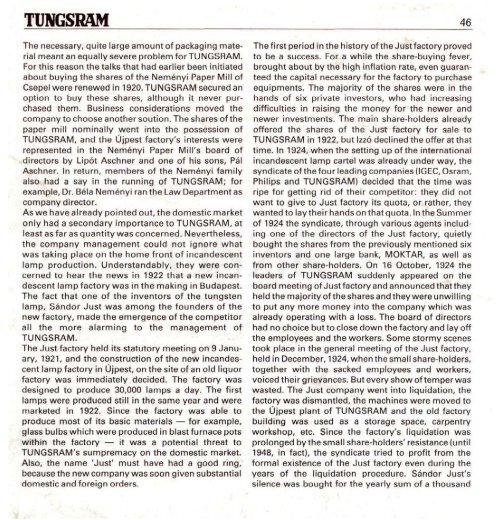THE HISTORY OF TUNGSRAM 1896-1945 - MEK
THE HISTORY OF TUNGSRAM 1896-1945 - MEK
THE HISTORY OF TUNGSRAM 1896-1945 - MEK
- No tags were found...
You also want an ePaper? Increase the reach of your titles
YUMPU automatically turns print PDFs into web optimized ePapers that Google loves.
<strong>TUNGSRAM</strong>^•rV46The necessary, quite large amount of packaging materialmeant an equally severe problem for<strong>TUNGSRAM</strong>.For this reason the talks that had earlier been initiatedabout buying the shares of the Nemenyi Paper Mill ofCsepel were renewed in 1920. <strong>TUNGSRAM</strong> secured anoption to buy these shares, although it never purchasedthem. Business considerations moved thecompany to choose another soution. The shares of thepaper mill nominally went into the possession of<strong>TUNGSRAM</strong>, and the Ujpest factory's interests wererepresented in the Nemenyi Paper Mill's board of^kdirectors by Lipot Aschner and one of his sons. PalAschner. In return, members of the Nemenyi familyalso had a say in the running of <strong>TUNGSRAM</strong>; forexample. Dr. Bela Nemenyi ran the Law Department ascompany director. •^•.: ' •'.As we have already pointed out, the domestic marketonly had a secondary importance to <strong>TUNGSRAM</strong>, atleast as far as quantity was concerned. Nevertheless,the company management could not ignore whatwas taking place on the home front of incandescentlamp production. Understandably, they were concernedto hear the news in 1922 that a new incandescentlamp factory was in the making in Budapest.The fact that one of the inventors of the tungstenlamp, Sandor Just was among the founders of thenew factory, made the emergence of the competitorall the more alarming to the management of<strong>TUNGSRAM</strong>.The Just factory held its statutory meeting on 9 January,1921, and the construction of the new incandescentlamp factory in Ujpest, on the site of an old liquorfactory was immediately decided. The factory wasdesigned to produce 30,000 lamps a day. The firstlamps were produced still in the same year and weremarketed in 1922. Since the factory was able toproduce most of its basic materials — for example,glass bulbs which were produced in blast furnace potswithin the factory — it was a potential threat to<strong>TUNGSRAM</strong>'S sumpremacy on the domestic market.Also, the name 'Just' must have had a good ring,because the new company was soon given substantialdomestic and foreign orders.The first period in the history of the Just factory provedto be a success. For a while the share-buying fever,brought about by the high inflation rate, even guaranteedthe capital necessary for the factory to purchaseequipments. The majority of the shares were in thehands of six private investors, who had increasingdifficulties in raising the money for the newer andnewer investments. The main share-holders alreadyoffered the shares of the Just factory for sale to<strong>TUNGSRAM</strong> in 1922, but Izzo declined the offer at thattime. In 1924, when the setting up of the internationalincandescent lamp cartel was already under way, thesyndicate of the four leading companies (IGEC, Osram,Philips and <strong>TUNGSRAM</strong>) decided that the time wasripe for getting rid of their competitor: they did notwant to give to Just factory its quota, or rather, theywanted to lay their hands on that quota. In the Summerof 1924 the syndicate, through various agents includingone of the directors of the Just factory, quietlybought the shares from the previously mentioned sixinventors and one large bank, MOKTAR, as well asfrom other share-holders. On 16 October, 1924 theleaders of <strong>TUNGSRAM</strong> suddenly appeared on theboard meeting of Just factory and announced that theyheld the majority of the shares and they were unwillingto put any more money into the company which wasalready operating with a loss. The board of directorshad no choice but to close down the factory and lay offthe employees and the workers. Some stormy scenestook place in the general meeting of the Just factory,held in December, 1924, when the small share-holders,together with the sacked employees and workers,voiced their grievances. But every show of temper waswasted. The Just company went into liquidation, thefactory was dismantled, the machines were moved tothe Ujpest plant of <strong>TUNGSRAM</strong> and the old factorybuilding was used as a storage space, carpentryworkshop, etc. Since the factory's liquidation wasprolonged by the small share-holders' resistance (until1948, in fact), the syndicate tried to profit from theformal existence of the Just factory even during theyears of the liquidation procedure. Sandor Just'ssilence was bought for the yearly sum of a thousand








![Letöltés egy fájlban [4.3 MB - PDF]](https://img.yumpu.com/50159926/1/180x260/letaltacs-egy-fajlban-43-mb-pdf.jpg?quality=85)







